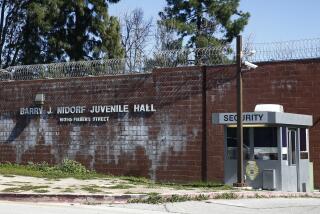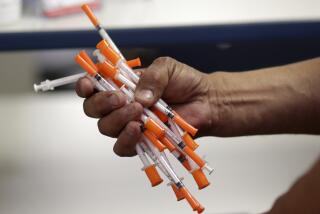Few Opt for Coroner Program for Drunk Drivers
A program to have youthful drunk drivers view the mangled bodies of accident victims has drawn far fewer participants than county officials hoped when they expanded it more than a year ago.
Only 82 people completed the program from late April through December, a period in which 300 or more could have attended, county coroner’s officials said.
“I guess we were overoptimistic. We thought it would expand much faster. I’m puzzled given all the effort we’ve put into it,” said Gary Siglar, the coroner’s official responsible for the county’s Youthful Drunk Driver Visitation Program.
Los Angeles County supervisors voted in September, 1990, to expand the program, which seeks to deter drunk driving by having first-time offenders under 22 spend several hours at the morgue, observe a shift at a local hospital and write an essay.
But judges in the Antelope Valley--the first area targeted by the supervisors for expansion--have not sent a single driver through the program in the past eight months, according to coroner’s officials.
Judge Richard Spann, the presiding judge of Antelope Municipal Court in Lancaster, said he has sent a few offenders to the program. Officials at the participating Antelope Valley Hospital Medical Center said they also recall several young people from the area taking part.
Still, according to coroner’s officials, only Long Beach Municipal Court, which launched the program as a pilot project in 1989, sent a sizable number of young offenders into the morgues in the past eight months. Drivers generally are offered the option in exchange for a lighter jail sentence or fine, but are not required to participate.
In addition to Long Beach, which sent 58, two courts each had 10 defendants complete the course, coroner’s officials said. The remaining four who completed the program came from two or three other courts, coroner’s officials said. All 24 Municipal Courts in Los Angeles County were invited to participate.
Long Beach Municipal Court Judge Bradford Andrews, a strong backer of the program, said judges elsewhere may not be offering it to young offenders or explaining the potential benefits.
Spann, who said he handles most of the Antelope Valley’s misdemeanor drunk driving cases, said he and other judges support the program. But he said he did not have many cases in which the program was appropriate, and could not say if its use will increase.
The county program, and those like it elsewhere, have drawn positive reviews from court and hospital personnel, who say the shock of seeing severely injured or dead accident victims can leave a lasting impression on young drunk drivers.
So the low participation rate came as a surprise to backers.
“I wasn’t aware of that,” said Lori Howard, an aide to county Supervisor Mike Antonovich, who asked the board to expand the program. “I wonder why the judges haven’t sent more cases.”
In addition to judges’ limited use of the program, the young defendants sometimes balk at the fees. The coroner’s office requires participants to pay $35, and the Lancaster hospital has a $30 fee, in addition to participants’ other fines.
Some offenders have had difficulty fitting into the twice-monthly schedule for the presentation at the coroner’s office, Andrews said.
Others have found it difficult to get to the downtown coroner’s office --especially if their driver’s licenses have been suspended and they must travel long distances.
In addition, up to half the people assigned by courts apparently are not attending the required sessions, coroner’s officials said. The 82 people who completed the program during the past eight months were among about 160 who were assigned, they said.
The program was authorized by the state Legislature in 1987, aimed primarily at youthful first-time drunk driving offenders.
The idea began with a judge in Sacramento about five years ago. The Orange County coroner since 1988 has had hundreds of participants view autopsies. Judges in Long Beach Municipal Court persuaded the Los Angeles coroner to begin a milder pilot program--participants are not present for the entire autopsy--in August, 1989.
More to Read
Sign up for Essential California
The most important California stories and recommendations in your inbox every morning.
You may occasionally receive promotional content from the Los Angeles Times.










